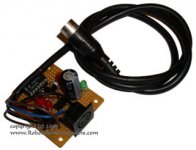rebeltaz
Experienced Member
After frying three C64s because of power supplies going bad, I decided enough was enough. I designed and built a circuit that goes between the power supply and the computer. If the 5vdc line drops below 4.5 volts or goes above 5.5 volts, or if the 9vac drops out completely, then a relay disconnects the power supply from the computer to prevent any damage.
Since, from what I've learned on here, this is a common problem with C64 supplies, I thought maybe others might be interested in the circuit as well. I was thinking about selling units on eBay, but I'm not sure what it would be worth. I figured I could also sell the schematic and PCB pattern (which I designed and laid out in Eagle CAD, a free electronic CAD software program) for maybe five or ten dollars.
What do you guys think? Is there a market for this device?
The picture here is the unit I built for myself. I like the open-air design, personally, but if I sell it, I will of course build it into a project box and I will also add a bypass switch to bypass the monitoring circuit if so desired.
Since, from what I've learned on here, this is a common problem with C64 supplies, I thought maybe others might be interested in the circuit as well. I was thinking about selling units on eBay, but I'm not sure what it would be worth. I figured I could also sell the schematic and PCB pattern (which I designed and laid out in Eagle CAD, a free electronic CAD software program) for maybe five or ten dollars.
What do you guys think? Is there a market for this device?
The picture here is the unit I built for myself. I like the open-air design, personally, but if I sell it, I will of course build it into a project box and I will also add a bypass switch to bypass the monitoring circuit if so desired.

